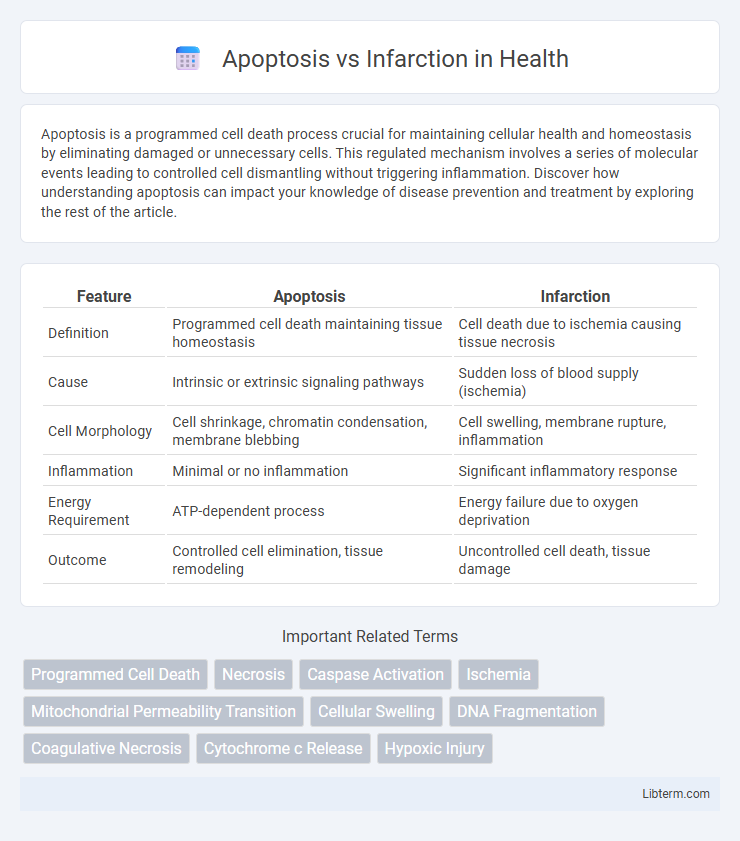Apoptosis is a programmed cell death process crucial for maintaining cellular health and homeostasis by eliminating damaged or unnecessary cells. This regulated mechanism involves a series of molecular events leading to controlled cell dismantling without triggering inflammation. Discover how understanding apoptosis can impact your knowledge of disease prevention and treatment by exploring the rest of the article.
Table of Comparison
| Feature | Apoptosis | Infarction |
|---|---|---|
| Definition | Programmed cell death maintaining tissue homeostasis | Cell death due to ischemia causing tissue necrosis |
| Cause | Intrinsic or extrinsic signaling pathways | Sudden loss of blood supply (ischemia) |
| Cell Morphology | Cell shrinkage, chromatin condensation, membrane blebbing | Cell swelling, membrane rupture, inflammation |
| Inflammation | Minimal or no inflammation | Significant inflammatory response |
| Energy Requirement | ATP-dependent process | Energy failure due to oxygen deprivation |
| Outcome | Controlled cell elimination, tissue remodeling | Uncontrolled cell death, tissue damage |
Introduction to Apoptosis and Infarction
Apoptosis is a regulated form of programmed cell death crucial for maintaining tissue homeostasis by eliminating damaged or unnecessary cells without provoking inflammation. Infarction refers to tissue necrosis caused by ischemia, resulting from the sudden loss of blood supply and leading to irreversible cell injury and inflammation. Understanding the distinct mechanisms of apoptosis and infarction is essential for diagnosing and treating various pathological conditions such as cancer, myocardial infarction, and stroke.
Defining Apoptosis: Programmed Cell Death
Apoptosis, or programmed cell death, is a controlled biological process where cells self-destruct in response to specific signals, maintaining tissue homeostasis and development. This mechanism involves a cascade of biochemical events leading to characteristic cell changes such as chromatin condensation, DNA fragmentation, and formation of apoptotic bodies. Unlike infarction, which results from acute ischemic injury causing uncontrolled cell death and tissue necrosis, apoptosis is an energy-dependent, regulated process essential for eliminating damaged or unnecessary cells without triggering inflammation.
Understanding Infarction: Pathological Cell Death
Infarction represents pathological cell death caused by the sudden obstruction of blood supply, leading to ischemia and irreversible tissue damage. This process contrasts with apoptosis, which is a regulated, programmed form of cell death essential for normal development and tissue homeostasis. Infarction commonly results in necrosis characterized by inflammation and loss of cellular membrane integrity, whereas apoptosis involves cell shrinkage and DNA fragmentation without triggering inflammation.
Molecular Mechanisms of Apoptosis
Apoptosis is a tightly regulated form of programmed cell death characterized by the activation of caspases through intrinsic mitochondrial pathways or extrinsic death receptor pathways, leading to DNA fragmentation and membrane blebbing without inflammation. Key molecular mechanisms involve the release of cytochrome c from mitochondria, formation of the apoptosome complex including Apaf-1, and activation of initiator caspase-9 followed by effector caspases such as caspase-3. In contrast, infarction results in necrotic cell death caused by ischemic injury, characterized by loss of membrane integrity and uncontrolled release of intracellular components, triggering inflammation.
Cellular and Molecular Events in Infarction
Infarction involves rapid and irreversible cell death due to ischemia, characterized by dense cytoplasm, loss of nuclei, and disrupted cell membranes, contrasting with apoptosis's programmed and orderly cellular dismantling. Molecularly, infarction triggers necrotic pathways with robust inflammation, including the release of damage-associated molecular patterns (DAMPs) that activate the innate immune response, whereas apoptosis engages caspases and mitochondrial cytochrome c release, maintaining membrane integrity and avoiding inflammation. The ischemic environment in infarction causes ATP depletion, leading to ionic imbalances, cellular swelling, and activation of proteolytic enzymes, which culminate in widespread tissue damage absent in the controlled apoptotic process.
Key Differences between Apoptosis and Infarction
Apoptosis is a programmed cell death process characterized by controlled cellular dismantling without inflammation, while infarction involves tissue death due to ischemia leading to inflammation and necrosis. Apoptosis maintains tissue homeostasis with cellular shrinkage and DNA fragmentation, whereas infarction results in loss of blood supply, cell swelling, and membrane rupture. The key differences lie in the mechanisms, with apoptosis being a regulated, energy-dependent process and infarction an uncontrolled, pathological response to oxygen deprivation.
Physiological Roles and Consequences
Apoptosis plays a crucial physiological role in maintaining cellular homeostasis by enabling controlled cell death without triggering inflammation, essential for tissue development and immune system regulation. Infarction involves irreversible tissue necrosis due to prolonged ischemia, leading to significant loss of function and inflammatory responses that can cause organ damage. While apoptosis supports normal tissue turnover and repair, infarction results in pathological consequences that often require medical intervention to restore tissue viability.
Clinical Significance and Disease Associations
Apoptosis plays a crucial role in maintaining tissue homeostasis and preventing tumor development by eliminating damaged or dysfunctional cells in a controlled manner. Infarction results from ischemic necrosis due to vascular occlusion, leading to irreversible tissue death often seen in myocardial infarction and ischemic stroke. Clinically, apoptosis is associated with chronic diseases like neurodegeneration and cancer, whereas infarction primarily underlies acute conditions requiring urgent intervention such as acute myocardial infarction and cerebral infarction.
Diagnostic Markers of Apoptosis vs Infarction
Diagnostic markers of apoptosis include caspase activation, Annexin V binding, and DNA fragmentation detected by TUNEL assay, which indicate programmed cell death characterized by cell shrinkage and chromatin condensation. Infarction is diagnosed by elevated serum levels of cardiac troponins (cTnI, cTnT), creatine kinase-MB (CK-MB), and lactate dehydrogenase (LDH), reflecting irreversible tissue necrosis caused by ischemia. Imaging markers like MRI with late gadolinium enhancement also distinguish infarcted myocardium from apoptotic tissue by revealing areas of necrosis and inflammation.
Therapeutic Implications and Future Perspectives
Targeting apoptosis offers promising therapeutic interventions to minimize cell death in ischemic conditions, while infarction typically involves irreversible tissue damage requiring advanced regenerative approaches. Emerging therapies focus on modulating apoptotic pathways to enhance cell survival and integrating stem cell or gene therapies to repair infarcted myocardium. Future perspectives include personalized medicine strategies and novel biomolecular agents designed to selectively inhibit apoptosis and promote tissue regeneration post-infarction.
Apoptosis Infographic

 libterm.com
libterm.com